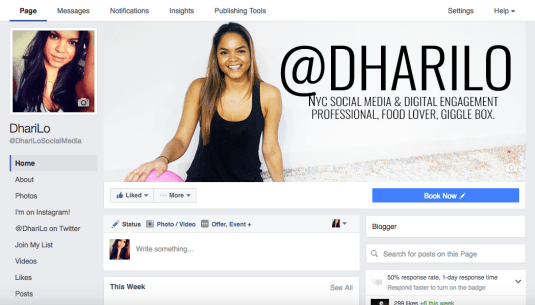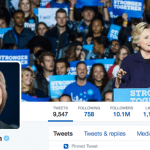Facebook has gotten a bad rap of late due to the gradual decrease in engagement for business Pages. And while it’s true that The Social Network isn’t always the easiest to get results from, it can deliver great benefits for your brand or business.
Facebook’s rolled out many tools in the past few years to help businesses and brands connect with their fans more seamlessly. But as with all social media marketing, creating an authentic feed that continuously grows organically comes with its own set of rules for businesses.
In this post I’ll review 12 Facebook for Business Do’s and Don’ts.
DO’s
1. Fill in All of Your “About” Sections and Take Advantage of Your Header Image
Step one in successfully using Facebook for business is to fill in your entire profile to the best of your ability. You want your customers to access all the info they need about your brand of company right from the Page. Having your bio sections filled in also helps when people are searching for your brand, so remember to include your keywords.
Part of filling in your entire profile is to post a profile and cover image. Recently Facebook changed the look of profiles, so now the entire cover image is displayed.
Take advantage of this valuable space.
Reinforce your branding, use text on the image to get your mission across, promote other networks or upcoming campaigns. You can even use the space to highlight customers, events, or the interior of your location.
I use a snapshot of myself and a quick snippet about me and what I write about.

2. Post Consistently
Social media marketing is a commitment.
Post consistently to stay in front of your audience’s eyes and keep growth going. Try starting at one post a day experiment from there. Remember to share content from other leaders in your industry, customers or resources. Snap some photos of your desk, take us behind the scenes at your awards ceremony – let your audience in on content they wouldn’t otherwise receive, providing as many reasons as possible for them to follow your Page.
3. Pin Posts to Your Profile
Pinning posts to the top of your profile is a great way to get more eyes on your content.
You can create a newsletter sign up, a post linking to your product landing page, or any piece of content you need to drive more traffic to. Pinned posts remain at the top of your profile until you take them down.
4. Use hashtags strategically
Hashtags on Facebook have been a little bit of a mystery, but recently a post from Social Media Today detailed findings from a BuzzSumo study which researched a billion Facebook posts from over 30 million brand Pages. The post details how posts without hashtags performed better than posts with hashtags.
But hold on – before you throw hashtagging on Facebook out the window there is something else to consider: social media search.
We know that social media networks are becoming search engines (and that using social media can boost search rank), so think about that when creating posts and choosing hashtags. Facebook’s Graph Search will pull your content depending on the keywords or hashtags users are searching for. So – to make this long story short – use hashtags on Facebook but put thought into which hashtags you use. When you choose hashtags for your next post, think about how people may be searching for your content topic.
Rule of thumb – don’t use more than 2 hashtags as the more hashtags your post has, the less engagement it may receive. As always with social media, what works with one brand may not work for another so my final answer is to test using posts with hashtags and without and pay attention to how they perform.
5. Analyze your account
Staying on top of your Facebook analytics is essential when using Facebook for business purposes.
Keep track of followers, reach, likes/comments and shares. Facebook offers in network analytics – simply click on “Insights” at the top of your Page and you’ll be able to explore your best posts, when fans are online, and even take a look at how the competition is doing.
You can download Facebook Insights if you’re really into data (and excel) to create your own charts and pick out patterns and similarities.
What KPI’s should you track? That depends on your goals. I keep track of everything – but the metrics I pay attention to are likes (and any spurts), organic reach, engagements (comments, shares, likes and reactions), link clicks and call to action button clicks. I like taking a look at how everything correlates to each other (for example a peak in likes or engagement because of being tagged in a post).
6. Plan
Your Facebook account is an extension of your brand. Just as you would carefully plan any other initiative, plan your Facebook posts and images.
Test different caption lengths and visual content forms. Take your discoveries from diving into analytics and let them guide your upcoming posts.
7. Use Facebook Specific Tools
Facebook has a ton of fun tools for brands to take advantage of. You can use Facebook’s built in Polls feature to get your audience to answer questions, or try presenting your content in a different way using Canvas or Instant Articles.
The network just launched a new set of tools that include easier ways for fans to buy tickets – the latest of the regular updates Facebook releases.
8. Set up Call to Action and Messaging Buttons
Make it super easy for fans to get in contact with your business with call to action buttons and messaging.
Call to action buttons include “call now”, “book now”, “use app”, “play game”, “shop now”, “sign up”, and “watch video”.
To enable direct messaging from your Page, navigate to your Facebook Page settings, and from “General” click on “Messages”, then click on “Allow people to contact my page privately by using the message button” and you should be all set. Facebook has a lot of messaging options to help you manage inquiries.
To set up your call to action button, navigate to your cover image and click on “Add Button” – depending on which call to action you choose you’ll get instructions on how to set it up.
One last thing – be timely in your responses once customer do start contacting you.

Image Credit: Facebook
9. Go Live
Facebook Live videos present a great opportunity for reach and interaction from fans. Videos on Facebook get a lot of interaction, and Live Videos even have their own map showing all the live broadcasts happening around the world at any given time, providing a big opportunity to get in front of people.
Let your followers get to know your team, tease upcoming events, film product demos or simply have fun with Q & A sessions.
Here’s a a screenshot of the Live Videos map. You can play around with it here: https://www.facebook.com/livemap/
THE DON’Ts
10. Over post
Just like any other network (except for maybe Twitter and Snapchat) you don’t want to annoy your audience with too many posts.
Keep in mind the nature of your business – for example, if you’re a magazine or publication your fans may expect multiple posts a day. If your brand or business doesn’t need as frequent updates, start with one post a day for a stretch of time then go for 1 -2 posts a day to see how your audience reacts. If engagement and reach are good on each post, then you may benefit from multiple posts a day.
On the other hand if you post more frequently and notice higher “unlike” numbers, or more negative reactions then dial it back.
11. Post irrelevant content for the sake of engagement
Keep your posts closely related to interests of your target audience (and followers). Context is everything – so even if you’re going for more of a creative approach, or you’re sharing content from elsewhere, remember to tie it back to your business.
12. Ignore targeting
Targeting is SO important because it helps you avoid empty reach. Targeting is especially important when it comes to ads – do you want to spend money on nothing?
Think about the content or campaign you’re promoting and focus on what the interests of your target customers are. Facebook’s ad interface lets you get super-specific about who you’re reaching, with the ability to target everything from their income, to on-platform behaviors.
Another way to target posts and who your page posts are being showed to are Facebook’s Preferred Audience and Audience Restrictions. These tools will help you custom deliver content, and reach those who are most interested in your material.
My bonus piece of advice when using Facebook for business is to not buy Likes. It takes so much work, time and effort to sift out those pesky fake followers, and your business is what will hurt in the end.
I hope these tips can help you sort out the Facebook for business world a little better.
[Source:-Social media Today]







